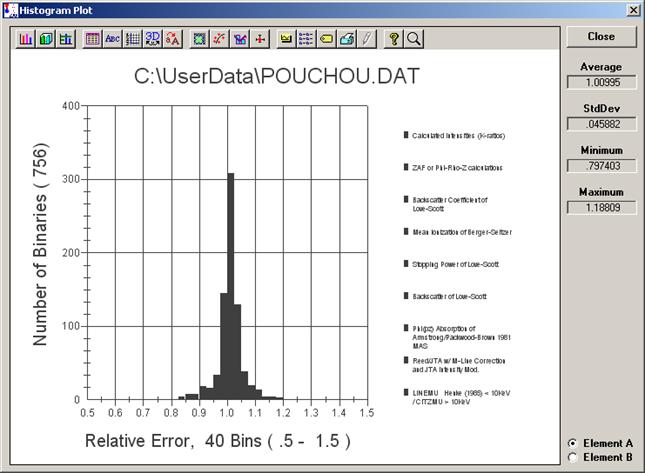Calculate Binary Intensities (Output Calculated Intensities and Error Histogram)
This menu item will allow the user to select an input file of binary compositions for the calculation of error histograms. The calculations are based on the current ZAF and MAC selections. The output is filtered using the options in the Binary Calculation Options dialog.

Note that all input files for binary calculations have a .DAT extension and must conform to the format specified below. Do not confuse these k-ratio files with normal CalcZAF input files (File | Open menu) or other files with the extension .DAT.
Some sample input files of binary compositions are supplied, e.g.,
AUAGCU2.DAT Au-Ag-Cu alloy k-ratios from NIST (measured at 52.5 takeoff)
NISTBIN.DAT NIST k-ratio database (compiled by Heinrich)
NISTBINA20.DAT NIST k-ratio database (compiled by Heinrich), Absorption correction > than 20%
NISTBINZ10.DAT NIST k-ratio database (compiled by Heinrich), Atomic Number correction > than 10%
POUCHOU.DAT Pouchou k-ratio database
POUCHOUA20.DAT Pouchou k-ratio database (compiled by Heinrich), Absorption correction > than 20%
POUCHOUZ10.DAT Pouchou k-ratio database (compiled by Heinrich), Atomic Number correction > than 10%
An example of the file format is seen here:
79 29 2 5 15. 52.5 .8015 .1983 .7400 .0
79 29 2 5 15. 52.5 .6036 .3964 .5110 .0
79 29 2 5 15. 52.5 .4010 .5992 .3120 .0
79 29 2 5 15. 52.5 .2012 .7985 .1450 .0
The data file format assumes one line for each binary. The first two columns are the atomic numbers of the two binary components to be calculated. The second two columns are the x-ray lines to use ( 1 = ka, 2 = kb, 3 = la, 4 = lb, 5 = ma, 6 = mb, 7 = specified, that is, do not calculate the intensity). The next two columns are the operating voltage and take-off angle. The next two columns are the weight fractions of the binary components. The last two columns contains the k-exp values for calculation of k-calc/k-exp. If the second element x-ray line is "specified" (iray = "7"), then no experimental k-ratio value is required.
Note that although the k-ratio file format example above has two emitting elements (so that two k-ratio error sets will be calculated), only one emitting element per line is actually required, as in the following example (where the x-ray line of "7" indicates an element by difference):
13 26 1 7 20 52.5 0.241 .0 0.124 .0
13 26 1 7 25 52.5 0.241 .0 0.098 .0
13 26 1 7 30 52.5 0.241 .0 0.083 .0
26 13 1 7 20 52.5 0.759 .0 0.736 .0
26 13 1 7 25 52.5 0.759 .0 0.742 .0
26 13 1 7 30 52.5 0.759 .0 0.748 .0